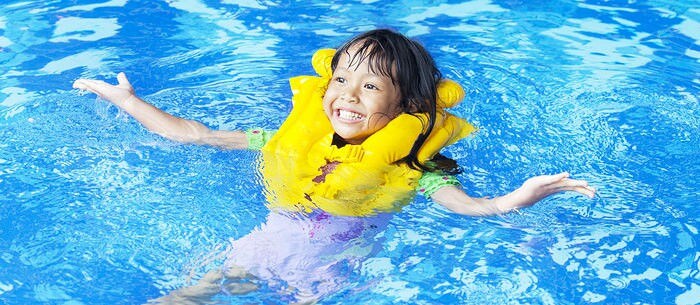Fun summer memories are often filled with days swimming in pools, but those long, lazy days mean parents have to ramp up their vigilance about pool safety for kids. In one split second, kids can find themselves in trouble. Kate Carr understands that all too well. She will never forget a vacation she took as a kid. “I jumped into the hotel pool, and I didn’t know how to swim,” she remembers. “I almost drowned.”
Stories like Carr’s don’t always have a happy ending. Drowning is the leading cause of injury-related deaths for kids ages 1 to 4, according to the U.S. Consumer Product Safety Commission. That’s why it’s so important for parents and caregivers to learn about pool safety for kids — and to pass those lessons on to their children.
Carr, president and CEO of Safe Kids Worldwide, and Connie Harvey, director of Aquatics Centennial Initiatives for the American Red Cross, share what you can do and what you can teach your kids to keep them safe at the pool.
Here’s what to do to keep children safe:
- Actively watch children. If your child is not yet a strong swimmer, stay within arm’s reach in the water. Once your child learns to swim, it’s OK to stay out of the pool as long as you never take your eyes off her. “Pay attention,” says Harvey. “Don’t text, read or have a conversation.”
- Designate a “Water Watcher.” At a pool party, adults should take 30-minute shifts being the Water Watcher. This person should hold something like a whistle or a Pool Safely Water Watcher card so everyone knows not to distract him.
- Stay just as vigilant at the baby pool. “Kids can drown in as little as 1 inch of water,” says Carr.
- Outfit kids properly. Any child that’s not a strong swimmer should wear a U.S. Coast Guard-approved personal flotation device. These life jackets and vests come in many kid-friendly designs and colors. Harvey suggests letting your child pick one. “That way, she’ll be more likely to wear it,” she says.
- Enroll kids in swim lessons. “Keep them in lessons at least until they can get to the surface and get out of the pool if they fall in,” says Harvey. Kids should know how to tread water and float. Babies as young as 6 months can join a parent-and-child swim program to gain water comfort. Kids can typically start taking swim lessons by themselves around 4 years old, says Harvey, although some children may be ready earlier, and some not until they are a little older.
- Learn CPR. Every parent and caregiver should know how to perform CPR in an emergency. Hospitals, fire departments and recreation centers offer CPR classes.
Here’s what to teach kids so they can stay safe:
- Ask permission before entering a pool area. “Often, drownings happen when nobody intended to be in the water in the first place,” says Harvey. So tell kids never to go near a pool area without asking an adult first.
- Walk — don’t run — near a pool. The wet, slippery surface could make it easy to fall into the water.
- Buddy up. Kids who can’t swim should never be in the water without an adult. Once kids learn to swim, they should still do so with a partner. “Nobody should ever swim alone — not even adults,” says Harvey.
- Stay away from drains and filters. Kids can get limbs, hair or clothing trapped in pool drains and filters. “The suction is often so strong that even adults can’t pull them out,” says Carr.
- Play safely in the water. Avoid breath-holding games, like seeing who can hold their breath the longest underwater. “These games are really dangerous,” says Harvey. “They can cause even elite swimmers to lose consciousness and die.” Rough horseplay is also dangerous.
- Only dive in designated areas. The American Red Cross recommends not diving in water that’s less than 9 feet deep because people can strike their heads on the bottom or side of a pool that’s too shallow or not wide enough. At public pools, signs will indicate if and where diving is allowed.
- Use slides and diving boards properly. Ask lifeguards the rules for waterslide and diving board use. Water slides often have a height requirement, says Harvey, and while there is no age limit on diving, kids should not dive until they can swim well enough to get themselves to safety. Generally, kids should go down water slides one at a time while seated on their bottoms and off diving boards one at a time in a forward position. They should swim to the side of the pool immediately to make room for the next person.
Once you’ve gotten the hang of pool safety for kids, remember to have a good time! “Make swimming a fun, pleasurable experience,” says Carr. “Every child should feel comfortable and enjoy being in and around water.”
For more safety advice, check out these summer safety tips.
Jennifer Marino Walters is a Washington, D.C.-based writer specializing in parenting and children’s topics. Her 3-year-old twins recently started swim lessons.






